
Melaleuca radula, commonly known as graceful honey-myrtle, is a plant in the myrtle family, Myrtaceae and is endemic to the south-west of Western Australia. It is an open, spreading shrub with narrow leaves, profuse pink or purple flowers in late winter and smooth, almost spherical fruits.
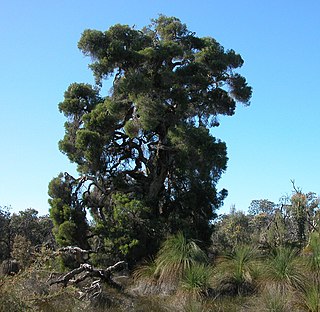
Melaleuca preissiana, commonly known as stout paperbark, modong or moonah, is a plant in the myrtle family, Myrtaceae and is endemic to coastal areas of southwest Australia. It is a shrub or small tree with papery bark, small leaves and spikes of usually white flowers. It occurs chiefly in areas that are seasonally wet.

Melaleuca huegelii, commonly known as chenille honey-myrtle, is a plant in the myrtle family, Myrtaceae and is endemic to the south-west coastal areas of Western Australia. It has small, almost scale-like leaves and flower spikes sometimes more than 100 millimetres (4 in) long on the ends many of its branches.

Melaleuca fulgens, commonly known as the scarlet honey myrtle, is a plant in the myrtle family Myrtaceae, and is endemic to Western Australia, South Australia and the Northern Territory. It is notable for its showy orange, red or purple flowers, unusual foliage and fruit, and is a popular garden plant. It is a member of Melaleuca, a large and diverse genus whose members range from large trees such as M. quinquenervia, to small shrubs.
Melaleuca penicula is a plant in the myrtle family, Myrtaceae and is endemic to the south of Western Australia. It is a rare species only known from the Fitzgerald River National Park and resembles Melaleuca eximia with its spikes of red flowers but its leaves and stamen bundles are different.

Melaleuca amydra is a plant in the myrtle family, Myrtaceae and is endemic to the south-west of Western Australia. It is similar to Melaleuca ryeae with its small, compact form, oval leaves and "pom-pom" heads of pink to purple flower heads on the ends of the branches in spring.

Melaleuca barlowii is a plant in the myrtle family, Myrtaceae and is endemic to the south-west of Western Australia. It is similar to a number of other Western Australian melaleucas such as M. conothamnoides with its purple pom-pom flower heads but is a more erect shrub with different leaves and the fruiting clusters have a different shape.
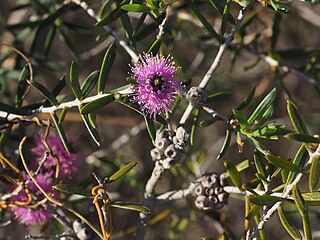
Melaleuca caeca is a plant in the myrtle family, Myrtaceae and is endemic to the south-west of Western Australia. It is similar to a number of other Western Australian melaleucas such as M. pentagona with its purple pom-pom flower heads but it is a smaller shrub with narrower leaves and smaller inflorescences.
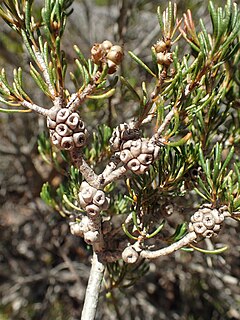
Melaleuca clavifolia is a plant in the myrtle family, Myrtaceae and is endemic to the south-west of Western Australia. It is a small shrub similar to Melaleuca tinkeri, with "pom-pom" heads of pinkish flowers and soft, silky hairs on the new growth but it has larger flower heads and its leaves are shorter, more club-shaped and have less distinct oil glands.

Melaleuca fabri is a plant in the myrtle family, Myrtaceae and is endemic to the south-west of Western Australia. It features strap-like leaves with distinct veins and spikes of pinkish flowers, the buds of which are covered with short, soft, silky hairs.

Melaleuca glena is a plant in the myrtle family, Myrtaceae and is endemic to the south of Western Australia. It is similar to the commonly cultivated Melaleuca nesophila with its purple "pom-pom" flower heads but is a smaller shrub with the inflorescences much more often on the sides of the branches and only occasionally on the ends.

Melaleuca hollidayi is a plant in the myrtle family, Myrtaceae and is endemic to the south of Western Australia. It is a small shrub with fine hairs like spider web on its leaves, and bright pink flowers.

Melaleuca societatis is a plant in the myrtle family, Myrtaceae and is endemic to the south west of Western Australia. It is a dwarf shrub with small, fleshy leaves and many heads of pink or purple flowers in spring, followed by "soccer-ball" fruit.

Melaleuca parviceps, commonly known as rough honey-myrtle is a shrub in the myrtle family, Myrtaceae, and is endemic to the south-west of Western Australia. It is a shrub with varying shades of pink or purple flowers, the stamens tipped with yellow anthers. In describing it, John Lindley noted: "every twig ... is terminated by hemispherical heads of brilliant pink". It is similar to Melaleuca manglesii and Melaleuca seriata.

Melaleuca spathulata is a shrub in the myrtle family, Myrtaceae, and is endemic to the south-west of Western Australia. It is a well known garden shrub featuring dark green leaves against light-coloured foliage, many twisted branches and profuse heads of bright pink "pom pom" flower heads in spring or early summer.
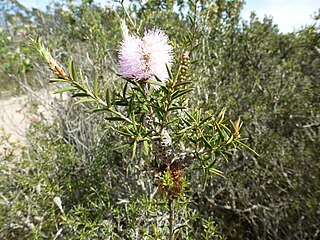
Melaleuca striata is a plant in the myrtle family, Myrtaceae, and is endemic to the south of Western Australia. It has distinctive leaves and heads of pink to mauve flowers, usually in late summer.

Melaleuca suberosa, commonly known as corky-bark honey-myrtle or corky honeymyrtle, is a shrub in the myrtle family, Myrtaceae, and is endemic to the south of Western Australia. It is a distinctive shrub, recognised by its tiny, crowded leaves, corky bark and pink flowers that appear along lengths of leafless parts of the branches.
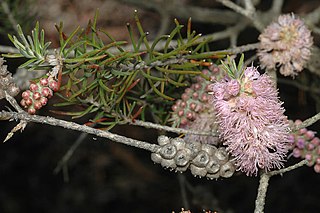
Melaleuca subfalcata is a shrub in the myrtle family Myrtaceae, and is endemic to the south of Western Australia. It has fibrous bark and pink to purple flowers in spikes, mostly on the side branches.
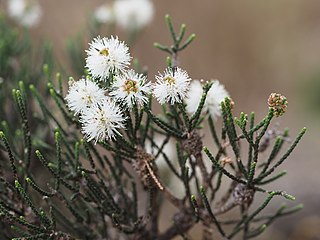
Melaleuca thyoides, commonly known as salt lake honey-myrtle is a plant in the myrtle family, Myrtaceae and is endemic to the south-west of Western Australia. It is an erect shrub with grey, papery or fibrous bark and very small, overlapping leaves on thin branchlets. It is a salt tolerant species often found on the edges of salt lakes.

Melaleuca glauca, commonly known as Albany bottlebrush is a plant in the myrtle family, Myrtaceae and is endemic to the south-west of Western Australia. It is a tall shrub with glaucous leaves and spikes of red flowers in spring.






















